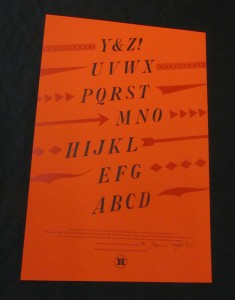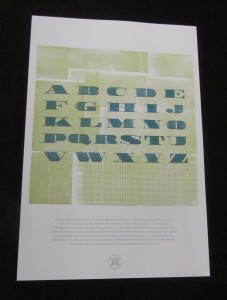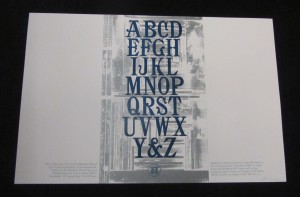Client News: Hamilton Wood Type reveals four, new limited-edition type specimen sheets; sponsored by Appleton Coated
 Appleton Coated announces four, new limited-edition type specimen sheets from Hamilton Wood Type and Printing Museum. Numbers 5-8 in the series, the specimens feature three Hamilton fonts and one from the William Page collection. Appleton Coated showcases these classic typefaces and letterpress printing on Utopia® coated papers and Curious Collection® papers.
Appleton Coated announces four, new limited-edition type specimen sheets from Hamilton Wood Type and Printing Museum. Numbers 5-8 in the series, the specimens feature three Hamilton fonts and one from the William Page collection. Appleton Coated showcases these classic typefaces and letterpress printing on Utopia® coated papers and Curious Collection® papers.
These specimen sheets are among the first artifacts to be printed at the museum’s relocation within Two Rivers, Wisconsin. “After nearly a year of packing, loading, moving and fixing, we are happy to complete the successful transition and welcome visitors to our new home,” says Hamilton Wood Type and Printing Museum’s director, Jim Moran.
Hamilton’s assistant director Stephanie Carpenter, designed specimen sheet No. 5, printed on Curious Matter Desiree Red 100-pound cover sheet, using Hamilton’s #235 font. J.E. Hamilton resorted to a numeral-based naming system because of the proliferation of wood type variations. This handsome high-contrast italic font was used widely in advertising during the late 19th and early 20th centuries. Curious Matter, an avant-garde paper made with potato starch, provides a toothy finish allowing the strokes of this font to create a debossed effect that both compresses the fiber and provides contrast in the paper finish when printed via letterpress.

Jim Moran designed specimen sheet No. 6 and printed on Curious Metallic White Gold 111-pound cover sheet using Hamilton’s #169 font. This font with its elegant swash terminals evokes the design sensibilities of the Art Nouveau, which dominated the late 19th century. Type manufacturers were eager to embrace this trend, which was founded in Europe, but found wide acceptance in the Americas. Metallic papers are especially well suited for the application of oil-based ink. After drying the contrast between paper and ink is especially noticeable.
 Hamilton’s artistic director Bill Moran designed both specimen sheet No. 7 and No. 8. Specimen sheet No. 7 was printed on Utopia Two:Xtra Green (U2:XG) Ivory Matte 60-pound cover using Hamilton’s Fat Face Roman font. Moran explains, “Fat Face Roman was a widely copied typeface by all major U.S. type makers. The extremely bold face was the byproduct of early American printing where typefaces were expected to ‘shout.’ This face prints handsomely on this ivory matte sheet giving both a muted finish to the ink, while holding on to the subtle hues of letterpress ink.”
Hamilton’s artistic director Bill Moran designed both specimen sheet No. 7 and No. 8. Specimen sheet No. 7 was printed on Utopia Two:Xtra Green (U2:XG) Ivory Matte 60-pound cover using Hamilton’s Fat Face Roman font. Moran explains, “Fat Face Roman was a widely copied typeface by all major U.S. type makers. The extremely bold face was the byproduct of early American printing where typefaces were expected to ‘shout.’ This face prints handsomely on this ivory matte sheet giving both a muted finish to the ink, while holding on to the subtle hues of letterpress ink.”
Specimen sheet No. 8 is printed on U2:XG Matte 100-pound cover using William Page’s #114 font. William Page started his company in 1856 in Norwich, Conn., and sold his company to Hamilton in 1891. “For 35 years, William Page produced some of the most ornate wood type ever produced in the U.S.,” elaborates Moran. “ The slender serifs a nd ornamental terminals of this Civil War-era font reproduce beautifully on coated paper. Utopia is especially well suited for showing the fine grain of wood type and printer’s reglet (spacing material), which was used to print the background of this specimen.”
nd ornamental terminals of this Civil War-era font reproduce beautifully on coated paper. Utopia is especially well suited for showing the fine grain of wood type and printer’s reglet (spacing material), which was used to print the background of this specimen.”
Incorporated 125 years ago in 1889, Appleton Coated has seen many Hamilton fonts printed on its papers. In 2012, Appleton Coated became an official sponsor of the museum’s type specimen sheet archiving program and documentation of its type collection. Appleton Coated provided additional support to the museum during its relocation to 1816 10th Street in Two Rivers, Wisconsin.
To commemorate the move, the museum announced an initial public offering (IPO) for two-year Hamilton Museum Charter Memberships. The IPO Certificates may be purchased for $100 each. The memberships are only a part of the Sustainer’s Fund, which plans to raise additional funds for the museum’s future success. Designed by Charles S. Anderson Design Co. and letterpressed by Studio On Fire, each certificate bears the impression a single letter or ampersand from Hamilton’s vast collection.
As curators of one of the premier wood type collections in the world, Hamilton Wood Type and Printing Museum is the only museum dedicated to the preservation, study, production and printing of wood type. Hamilton’s collection has grown to 1.5 million pieces of wood type and more than 1,000 styles and sizes of patterns.
Self-guided tours of Hamilton Wood Type and Printing Museum are available Tues.-Sat., 10 a.m.-5 p.m. Guided tours of the museum are provided on the hour in the afternoon from 1 to 4 p.m. Hamilton staff host educational demonstrations, field trips, workshops and offer opportunities for artists, printers, historians and other scholars to experiment with its collection. Learn more at http://www.woodtype.org.
###
Filed under: Appleton Coated, CLIENT NEWS, Type-Paper-Print